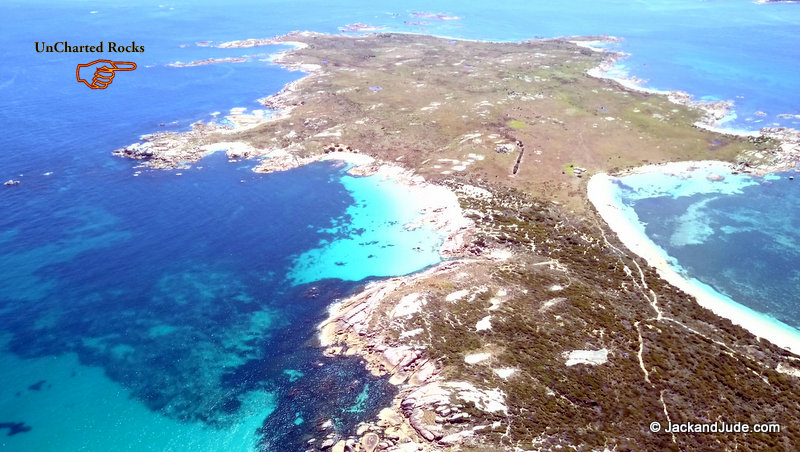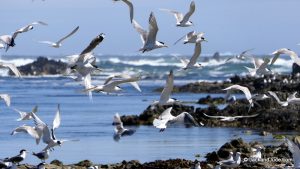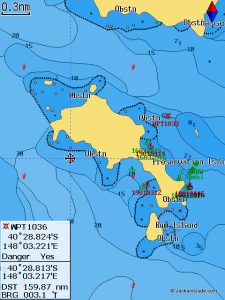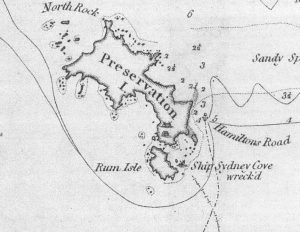Historical Shipwreck Revisited
 Mysterious Location
Mysterious Location
Jack and Jude are hiding out in one of Australia’s best kept secrets, a place few know and one that’s rarely mentioned in our schools even though it’s one of the most important islands in Australian history.
Do we hear, “surely you jest? An island so important, yet few know about it!”
Yes, it’s a mysterious location and we are hiding in it, surrounded by beauty in grand proportions in one of Nature’s strongest realms. Hiding not from the law or the masses, but hunkered down against blasts of fury straight out of Bass Strait. And you know they’re not called the Roaring Forties without good reason.
Our Passage
Leaving Macquarie Harbour on the west coast of Tasmania, we voyaged overnight to King Island, where we enjoyed nine lovely days celebrating Christmas with friends. We then day-sailed quickly south-east to Three Hummocks Island, which lies near the northwest tip of Tasmania, where we crawled early into bed for a much needed rest before hoisting sail again next day to tackle the length of Bass Strait in one marathon overnight run that brought in the New Year. En-route, strengthening westerly winds served up sloppy seas, nevertheless we navigated safely to a rarely visited area of Banks Strait that is plagued by fast running currents and many hard to see obstacles. Anchoring close to shore at Hamilton Roads on Preservation Island, we hoped to evade the worst of the current and strong weather. There we bobbed and swayed for a couple of days while that weather system did its thing.
Patience rewarded
When at last the high-pressure cell had moved directly over us, it brought sunny calm seas of the loveliest cobalt blue that was as transparent as the finest plate glass. Excited with anticipation we moved our ship around to what had been the weather beaten coast, now flat calm like the smoothest satin sheets, and happily anchored within rowing distance to what is one of the most impressive bits of real estate in all of Australia.
Preservation Island Revisited
Sitting closely next to slender Preservation Island like a child next to its mother is an island some may have heard of, because it was named Rum Island by the rescuers of the crew of the Sydney Cove. It was on Rum Island that the ship’s captain Guy Hamilton had ordered the salvaged barrels of rum be put for safekeeping, well away from his despondent and desperate crew. Like Preservation Island, it’s also dotted with towering granite tors splashed with orange lichen, and it has the most magical, fantasy backdrop of variegated greens dotted here and there with pockets of the purest vanilla sand.
When we mention that these islands are located in The Furneaux Group, people ask, “Where’s that?” Answering them, we say it’s in resort country without a resort, with Preservation Island the piece de résistance. You may find this hard to believe, but we believe it’s one of the most important islands in Australia, and yet, it hardly rates a mention in our schools. Why? Well, if you watch our film “Summer 16” you will learn a lot more about this very important moment in Australian history.
Down Memory Lane
 Jude was beside herself with joy at seeing her old friends again, the mighty granite tors and majestic Cape Barren Geese made a powerful potion that revived fond memories of our filming her re-telling the heroic story of fifty-two stranded men.
Jude was beside herself with joy at seeing her old friends again, the mighty granite tors and majestic Cape Barren Geese made a powerful potion that revived fond memories of our filming her re-telling the heroic story of fifty-two stranded men.
No tracks, no trails, no trees, just open landscape with inspiring sea views in all directions brought Nature’s sounds to our ears. Large glossy white Pacific Gulls sharply called with beaks coloured as if dipped in red ink, in quite remarkable contrast to the grey geese that always pair for life communicating in honks, one bass the other alto.
Our second day ended abruptly while exploring Rum Island, when rolls of thick fog seen approaching out the west forced us back to Banyandah to retreat back to the east side of the island. (see uncharted rocks) Where once again we found our 2016 anchorage in Horseshoe Bay, and endured more days of scudding grey clouds and high-pitched westerly winds. Which explains why this is resort country without a resort.
History
Not that long ago when Australia was a mere infant nation, when famished colonists and convicts wondered when their next meal might arrive from across the seas, a tiny wisp of a sailing ship, renamed the Sydney Cove in honour of the fledgling colony, set out from India of all places. Loaded with much needed sustenance as well as many barrels of good rum, this somewhat frail craft that had been a coastal trader until called upon to deliver this precious cargo, ran into trouble crossing the very same Roaring Forties that are presently battering us.
There’s not enough space here to fully recount this story that ended in tragedy. Only sufficient to mention that white man’s very first overland trek on Australian soil was undertaken by members of that ship seeking salvation and the rescue of their shipmates. How those hearty brave souls survived two months in a hostile land finding food and water along the way will fill your hearts with wonder and admiration. It did ours. Jack and Jude were so moved that we made the film Summer 16 to highlight their achievements and showcase the impressive setting of their shipwreck and survival.
Sydney Cove:
The History and Archaeology of an Eighteenth-Century Shipwreck
For those wishing to read more of this amazing and important event in Australian History, Michael Nash, the maritime archaeologist who directed the excavation of the Sydney Cove, has produced a comprehensive account, which includes maps, photographs, and rare pictures of one of Australia’s most significant shipwrecks that we highly recommend. Our thanks to Michael for his kind permission to use some of this material in the making of our film Summer 16.
Uncharted Rocks
What all sailors dread – Fog and uncharted rocks. All our second morning anchored in West Bay, we explored Rum Island while a bank of fog sat low on the far distant west horizon, and when it began drifting closer, we packed away our toys and boarded Banyandah for a run back around the island. We have visited this area a number of times and know its shores are encumbered with off-lying rocks, so we are cautious.
Not very long after lifting our hook and clearing the first point going north, which has some above-water rocks jutting out from it, the fog closed in surprisingly quick. In no time at all, vision past the bow of our ship was diminished.
Jack was at the helm and made a turn to be well clear of the farthest rocks shown on our GME chart plotter. At the time, we were in 15 to 18 metres depth under keel and well outside the danger line. Reducing speed, both of us peered forward, talking glibly about the change of weather, when all of sudden Jude yelled, “turn hard left NOW.” And as I did so, this huge granite boulder came out the thickness. At the same moment, the sounder started to plummet and my heart began to race. Instinctively I made a waypoint.
Minutes later, the water deepened and the drama ended. Twenty minutes after that, the fog passed, leaving us with the question of “What the?” Looking back, there was a whole string of big rocks extending out from Preservation where nothing was shown on either of our plotters. Both use C-maps cards issued 2012 and 2005.

We’d anchored bottom of image in that sand patch, had cleared the last rock off the first point when the fog came in.
We have notified the Australian Hydrographic Office and wait to hear if Australian paper charts show these dangers. Understand, we are not trying to make a case against the chart makers – We are doing our job of passing on local knowledge as sailors have since the beginning of time. Over the years, as explorers and adventurers, we have on occasion been in dangerous waters where it is paramount to be diligent, maintain a careful watch, and remember that you are on your own.
That said, we’re perplexed.
In 1798, Matthew Flinders did a crackerjack job of charting these rocks. Why aren’t that they on today’s charts?
Here is a link to additional photos taken in 2016
Whispers on the wind
The beauty of the creation of Earth always inspires Jack and Jude with its perfection because everything seems to work seamlessly without command – that is until we come across mankind’s effect. Humans are dirty creatures, spreading their waste without regard for Earth or her creatures. Jack and Jude see human waste wherever we go, often in abundance. Even when far out into the oceans, or trekking isolated lands. That saddens us and makes us angry. Are we such uncaring beasts taking what we can with so little pride in who we are?
Rum and Preservation Islands are just two prime examples. Their pristine unaltered shores are fringed with our trash. Lengths of plastic rope, glass bottles, plastic containers and much more were easily seen amongst the seaweed and cuttlefish backbones and dead critters that nature absorbs. Nature’s waste is fine. It’s been building the natural world since creation, but our waste, which is also absorbed after it breaks down, is changing and destroying Earth.
Our prosperity depends on protecting the planet by Geoffrey Heal
USC Board professor and leading expert on economics and the environment.

The natural world provides everything we depend on. We get our food from the natural world, we get our drinking water and our oxygen from the natural world, and we evolve as part of it. We simply cannot live without it. Plants create food, and they need pollination from insects, and they need rain and they need soil. We cannot synthesize these things. So we really are totally dependent on the natural world in the end.
The strange thing is, people don’t acknowledge that anymore. We don’t see much nature. We are very embedded in our latest technologies, such as computer networks and our cell phones. There’s a sense that we do not depend on the natural world anymore. But that’s actually not true: we need it as much as our ancestors did and for the same reasons – to survive.
Wisdom
Jack and Jude see the wisdom in what Professor Heal says in the review of his book Endangered Economics, but we also think world over-population escalates our dilemma. Why is this not discussed a whole lot more? Young ones, don’t wait for our entrenched leaders. Too many are old school focusing on jobs and growth and little else except continued burning of fossil fuels. It’s you who’ll be managing Earth in no time at all and can save the planet and humanity, and you can have fun doing it. Get serious right now. Prepare yourself by learning all you can about the planet’s ecosystem and human’s effect. At the same time, get outdoors to be amazed by Nature. Organise the wise ones to take you out into the wilderness to teach you all they know about the forests and seas and other creatures, and how they interact with Earth’s ecosystem. And please stop listening to those telling you that exploiting the universe will find riches. We have plenty of riches right here on Earth.
Related articles:
Rum Island






